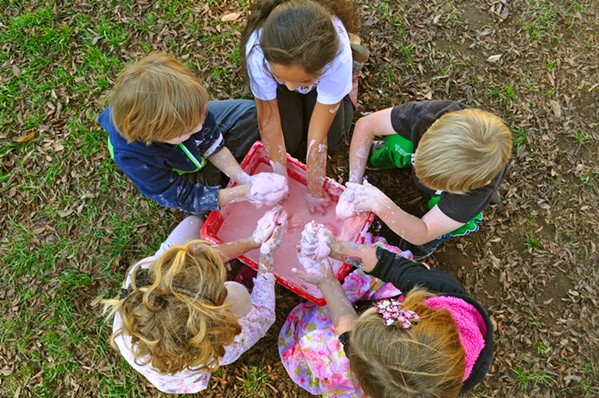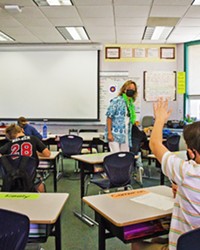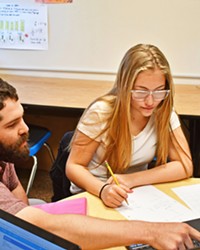
Universal public preschool is a concept long-discussed, and recently politicians started making serious policy proposals in pursuit of preschool for all.
President Joe Biden's American Family Plan released in late April proposes universal, high quality preschool for all 3- and 4-year-olds. In early July, Gov. Gavin Newsom signed legislation to make transitional kindergarten available to every 4-year-old in the state, and he hopes to expand preschool for even younger kids.

- Photo Courtesy Of SLCUSD
- EARLY LEARNING Local school district leaders say preschool is an equity issue, and new legislation signed by Gov. Gavin Newsom will expand pre-Kindergarten opportunities.
On the Central Coast, public preschool for some students has already been an option for a while. And while it's not universal yet, local school officials say Newsom's push for expanded transitional and pre-kindergarten could change the early learning landscape in the very near future. In the meantime, local public school districts are doing what they can to provide early learning opportunities to as many kids as possible—and they're approaching it through an equity lens. This means offering preschool to kids whose families couldn't afford it otherwise.
Santa Maria-Bonita School District (SMBSD) has had preschools in the district since 1997. The first one was implemented at Fairlawn Elementary, and today, the district has a preschool at all but five of its 17 elementary school sites.
"It's our goal to have a pre-kindergarten program at each of our elementary school sites," district Director of Teaching and Learning Jennifer Loftus said. "For the last school year we added Liberty and Libbon Elementary, and then going into this next school year we're adding Arellanes Elementary School."
Raquel Valdez, director of preschools at SMBSD, said funding for the district's preschools historically has been through the California State Preschool Program (CSPP) and the district's Local Control and Accountability Plan (LCAP) funds. And in late June, the district was awarded a First 5 grant that will allow it to add the new preschool at Arellanes Elementary School. The grant gives the district $150,000 annually for the next four years.
"The CSPP funding that we receive from the state does have requirements with it," Loftus said. "Students are eligible for pre-kindergarten if they meet certain eligibility criteria, and the primary factor is income."
San Luis Coastal Unified School District (SLCUSD) has run a preschool program called Success for All since 2013, paid for out of the school's general fund. Like SMBSD's program, it aims to reach "a specific targeted audience of students who otherwise wouldn't have an opportunity to attend preschool," SLCUSD Director of Learning and Achievement Rick Mayfield said.
Success for All is hosted at Baywood, Hawthorne, and Pacheco elementary schools.
"There are a lot of preschool programs out there and available in the community," Mayfield said. "But it's very challenging for families these days to be able to afford preschool programs, and if you have multiple children, it's really difficult."
While California districts are not required to offer the preschool programs, they are required to offer transitional kindergarten (TK) to some students. Preschool is an umbrella term under which pre-K and TK fall, and the difference between the two isn't that substantial in terms of curriculum. But, Mayfield said, it more comes down to age differences, when a child is born, and what schools are required to provide.
Current law requires school districts across California to offer TK to kids who turn 5 between Sept. 2 and Dec. 2, because Sept. 2 is the cutoff for kindergarten enrollment, Mayfield said. Newsom expanded that criteria when he signed Assembly Bill 130 into law on July 9, which will provide "free, high-quality, inclusive pre-kindergarten for all 4-year-olds, beginning incrementally in 2022-23 and with full implementation anticipated by 2025-26," according to Newsom's office.
"Right now, it's only limited to those students who [turn 5] in the fall," Mayfield said of existing law. "Let's say you turn 5 in January. You would be in preschool, as opposed to kindergarten. But what the state is saying is any 4-year old needs to be in a TK program. It'll mean there's TK programs at every school, and probably equal to the number of kindergarten classes that are there."
Loftus at Santa Maria-Bonita said she and her fellow school district leaders are "kind of in a holding pattern" as they await details on what the roll-out of expanded TK will look like.
"If we are offering transitional kindergarten to all of our students, [we're] thinking of blending pre-kindergarten with transitional kindergarten, because our pre-kindergarten [currently] serves primarily all 4-year-olds, and our transitional kindergarten serves those students who are not 5 in time to start kindergarten," Loftus said.
This leads to questions around what early learning would look like if TK expands to cover all 4-year olds.
"Are we then serving 3-year olds? Is that happening in the school system or is that happening more in a center-based child care, day care center type setting?" Loftus asked.
What district officials do know is that preschool—whether required by the state or not—is about increasing accessibility and equity. That's why both SLCUSD and SMBSD have made efforts to offer preschool to some children, even before being required to by the state.
"Traditionally, students who are underserved are coming from households that have lower income, their parents might be both working full time, it might be a single parent household, and just all of the different challenges that go along with being in that low-income threshold," Loftus said. "Before there's an achievement gap, there's a readiness gap. Many students of poverty are not ready to learn when they enter kindergarten."
Not only does preschool get kids ready for school, but it also builds a relationship between the district and families.
"In the program, we focus a lot on the social-emotional, and having those partnerships with families to support them and to get them ready for kindergarten," SMBSD Preschool Director Valdez said.
Mayfield said that kindergarten standards are quite rigorous, so having kids in pre-K or TK helps set them up for success.
"By the end of kindergarten, students need to be reading at a fairly high level; they need to have math skills," he said. "So getting them at 4 years old gives us the opportunity to help form their learning and prepare them for successful kindergarten experiences, and also to identify needs that students have and be able to plug them into programs, interventions that will serve their needs." Δ
Reach Staff Writer Malea Martin at [email protected].



Comments (2)
Showing 1-2 of 2